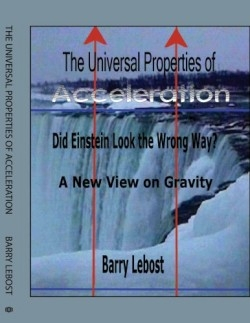The Universal Properties of Acceleration
A New View on Gravity
“Einstein’s instincts as well as his mathematics told him that gravity was caused by inertia,” the author writes. “But the concept of the earth’s surface accelerating outward into space seemed absurd. What if Einstein, Newton, et al., were physically prevented from observing the acceleration of the surfaces of planets and stars? Could this be possible?”
In The Universal Properties of Acceleration, after discussing the history of thought about gravity, acceleration, and inertia, Barry Lebost leads readers through a logical progression by means of thought experiments to see how gravity is the inertial effect of inflation’s acceleration. Lebost is an inventor who has worked with fluid dynamics; he also invented a wind turbine that generates heat directly from wind power and a jungle mosquito trap which may significantly reduce the spread of malaria.
Regarding physics, Lebost’s ideas stand tradition on its head. He believes that Newton’s separation of gravity from inertia provided a precedent that has continued until today, blinding scientists to reality and preventing the correct understanding of physical properties. Einstein came close to putting gravity and inertia back together, recognizing the mathematical implications and apparent similarity, but couldn’t logically reconcile the two completely. He developed the principle of equivalence so that he could proceed mathematically; this resulted in a curved space-time. Under Lebost’s theory, that curvature is only apparent as an illusion created by the expansion of inflation. Expansion also is the cause of the inertial experience we call gravity.
Furthermore, Lebost’s theory apparently requires an open system with massive amounts of energy input. The inflation of the big bang did not stop, but continues today in every atom. It is the driving force that shapes the phenomena we see at work in the universe, from black holes to the earth’s weather, plate tectonics, and why your eyes are on the front of your head instead of on top. The author writes, “Without a doubt, if it weren’t for the force of gravity, life forms would look quite different. Both the magnitude and the direction of force play roles in the design of physical anatomical structure.”
Lebost’s theory of Accelerated Concentric Radial Expansion (ACRE) challenges the status quo in physics theory, but the logic is thorough and convincing. If the big bang theory is correct, if inflation is true, this is a major step toward a unifying theory. Some parts of the book are a bit repetitive, and some of the digital illustrations have been enlarged to the point of fuzziness. Still, anyone interested in understanding physics should give this book a long, hard look.
Disclosure: This article is not an endorsement, but a review. The publisher of this book provided free copies of the book and paid a small fee to have their book reviewed by a professional reviewer. Foreword Reviews and Clarion Reviews make no guarantee that the publisher will receive a positive review. Foreword Magazine, Inc. is disclosing this in accordance with the Federal Trade Commission’s 16 CFR, Part 255.

